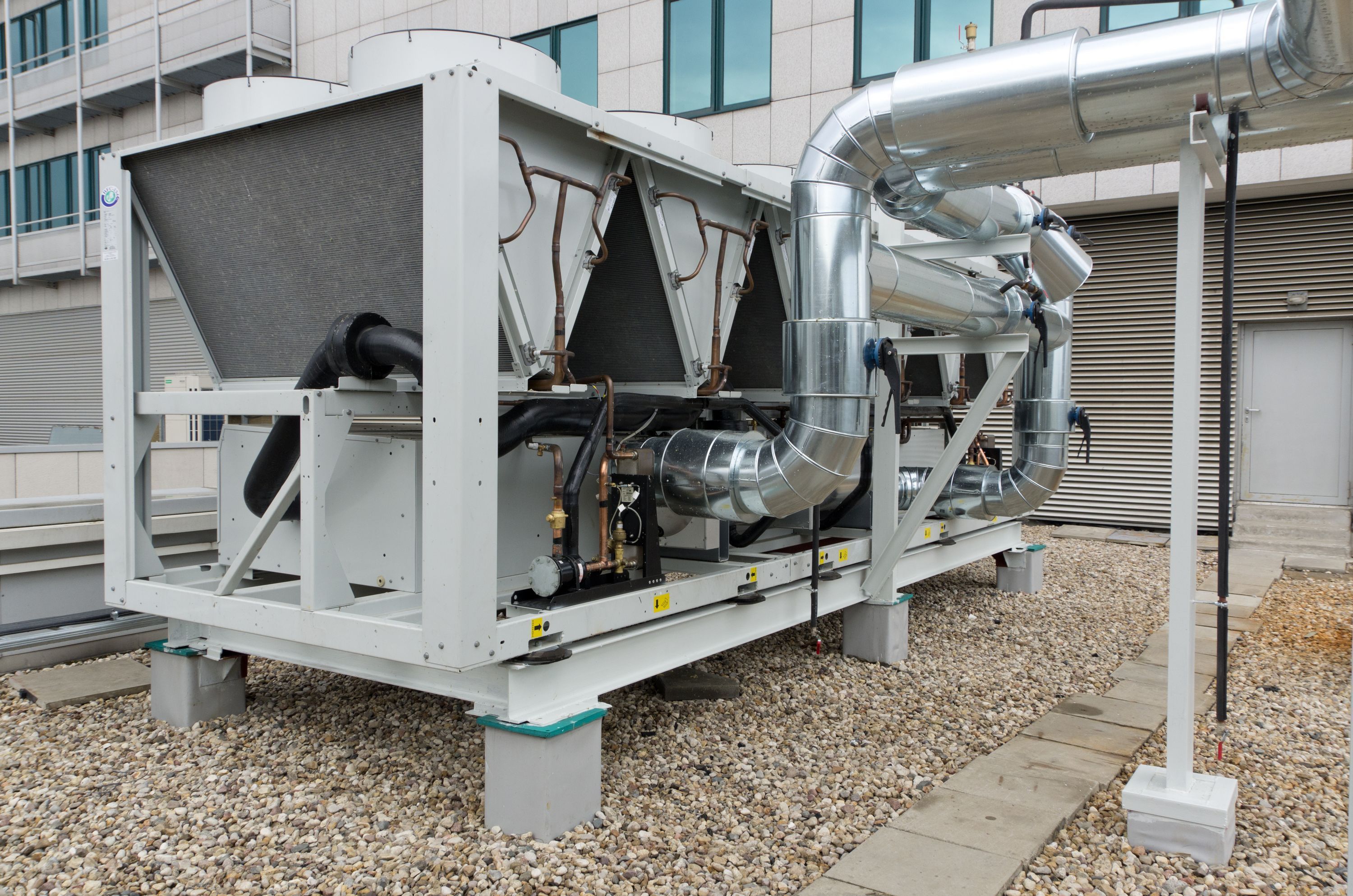Refrigerant choice in HVAC chillers
Climalife UK

Sajjun Lohia, UK Sales and Marketing Coordinator
In the Heating, Ventilation, Air Conditioning and Refrigeration (HVACR) industry, chillers play a vital role. Commercial facilities such as offices, hotels, restaurants, and hospitals are areas where chillers play an integral part. For many years commercial buildings have used HVACR systems as a method to cool and dehumidify the building but increasingly they are also being used to provide heat as well. Like other areas of the RACHP industry, there is an increasing need for these systems to be both sustainable and efficient.
Legislation is driving and influencing the choice of refrigerant. With the HFC phase down progressing and the next reduction step likely within the next couple of years, chiller manufacturers are already making moves to switch to lower GWP refrigerants.
There are several types of chiller, all different to each other. However, in terms of refrigerant they can be split into three types based on the pressure of the refrigerant.
Low Pressure Refrigerant Chillers
Low-pressure chillers increasingly use very low GWP R-1233zd (GWP = 4.5, AR4), which is an A1 safety class single component refrigerant as well as R‑514A (GWP = 7, AR4), an azeotropic B1 safety class refrigerant blend.
Medium Pressure Chillers
R-134a has been widely used in chiller applications. In the larger end of the chiller market there are equipment manufacturers who are still offering a range of equipment with R-134a as the primary option.

Whilst R-134a has a GWP of 1430 (AR4) and isn’t subject to any current bans in Great Britain (GB), the GB F-Gas regulation is still in the process of being revised and lower GWP alternatives are available. Many of the leading manufacturers of chillers, produce a range of air cooled, water cooled and remote condenser chillers that have a wide range of cooling capacities from 20kW up to 2MW most now have options designed for use with the refrigerants mentioned below.
R-513A is non-flammable and has a GWP of 631 (AR4). It has been quickly adopted by various manufacturers and has a similar cooling capacity and performance to R-134a. Meaning it can be used an easy option for retrofitting R-134a systems. R-513A has a GWP level less than half of the GWP of R-134a. This essentially means that twice as much becomes available compared to R‑134a in terms of the F-Gas HFC phase-down.
R-1234ze is a very sustainable long-term refrigerant, as it is a is a single component HFO with a very low GWP of 7. Available since 2012, it has been used in chiller applications, where R-134a was previously used. However, due to a lower cooling capacity it is not suitable as a retrofit option for R-134a.
The positives of using R-1234ze is the good energy efficiency compared to R-134a making it an ideal ultra-low GWP alternative to R‑134a in new equipment. Increased energy efficiency translates into lower indirect emissions and lower operating costs. Since R-1234ze is non-flammable below 30°C, for transportation (ADR) and manufacturing (PED/PE(S)R) purposes, it can be treated as non-flammable, even though it is classed as A2L under the ASHRAE 34 and ISO 817 standards. In the past the switch to R-513A has been easier to implement, in spite of that Climalife advises to always look at longer-term solutions in new equipment, with many manufacturers offering equipment using R-1234ze.
In 2020, R-515B was new to the market. Due to the almost identical characteristics as R-1234ze, R-515B can be described as an A1 (non-flammable) version. This creates an ideal solution as R-515B offers a low GWP alternative (293, AR4) in applications where the long-term solution R-1234ze (GWP<1) cannot be used due to its A2L safety classification.
R-1234yf can be considered a long-term sustainable refrigerant due to it being a single component HFO with a very low GWP of 4 (AR4). In terms of performance R-1234yf is very close to R-134a, meaning there are some chiller options available using it. However, due to the safety class difference, R-1234yf is better suited for use in new equipment.
Under the Pressure Equipment Directive (PED) R-1234yf is in fluid safety group 1. Although it could be possible to retrofit from R‑134a, any changes to the equipment PED classification need to be thoroughly considered as well as charge size restrictions from EN 378 and a suitable risk assessment will most certainly be required, which takes into account any possibility of the potential formation of flammable zones.
As both R-1234ze and R-1234yf have a very low GWP, this essentially means they both provide an unrestricted solution as the HFC phase-down tightens on higher GWP refrigerants in the years ahead.
High Pressure Chillers
R-410A has been extensively used in chillers, however due to its GWP of 2088 (AR4), it is not sustainable solution in new equipment as the F-Gas HFC phase down steps impact. The leading refrigerants are currently R-454B and R-32 neither of which are suitable as R-410A retrofit options and should only be used in equipment designed for these products. Some manufacturers are also looking at the medium pressure refrigerants previously mentioned as an alternative for this technology, for example scroll compressors for R‑1234ze are available and able to deliver the same capacity as for R-410A.
R-454B with a GWP of 466 (AR4) appears to be currently leading the way with a number of manufacturers as it is a close match to R-410A in terms of operating performance and properties and has the lowest GWP. We are seeing an increasing number of chiller manufacturers making this option available to the market.
R-32 with a GWP of 675 (AR4) has seen rapid growth as a replacement for R-410A in split AC systems and some manufacturers have also opted for R-32 in chillers. The properties of R-32 have meant that more equipment re-design may be required by equipment manufacturers.
Other refrigerants worthy of a mention are R-290 (propane) and R-717 (ammonia). Some manufacturers are offering HVAC systems using R-290 but the requirements for using an A3 highly flammable refrigerant can be a little more restrictive than using a lower or non-flammable option. Whilst EN 378 does not restrict charge sizes if the system is in the open air, suitable risk assessment taking into account the potential formation of flammable zones is required and likely to be significantly more restrictive than using a lower flammability option.
The use of R-717 is widespread in industrial chillers where the toxicity and flammability can be more easily managed but is rarely seen for general HVAC applications.
Looking to the future
Changing the refrigerant used in chillers is not always a fast process as there is range of criteria that it must meet. Criteria includes, operating at the desired pressure and temperature, providing the appropriate levels of cooling and of course be more energy efficient than its predecessors.
New chillers installed now need to work efficiently over their lifetime, which can be 20-30 years, so choosing a sustainable refrigerant is important. The chiller manufacturers are moving quickly in the right direction and already have a number of lower GWP options available to them to be able to meet the restrictions F‑Gas legislation creates.
There are many leading manufacturers that have released or are releasing equipment that is high performing, energy efficient and cost effective with the use of very low GWP refrigerants. These offer a long-term solution in order to future proof a buildings air conditioning system and to take steps towards tackling the pressing issue of climate change.
As these chillers become more established in the market, it’s important to make sure your refrigerant supplier is up to date on handling, use and performance of the new refrigerants and have availability. Climalife have a stock of all the refrigerants discussed.
